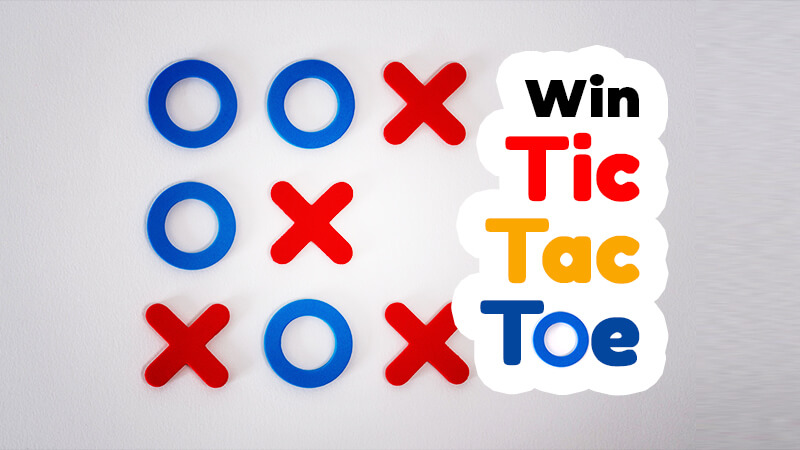How to Win Tic Tac Toe

Table of Contents
Tic Tac Toe, often regarded as a simple childhood pastime, hides a fascinating world of strategy beneath its straightforward surface. While many might dismiss it as a game of chance or boredom, the truth is that Tic Tac Toe offers an arena where tactics, cunning, and foresight can determine the victor.
In this article, we’ll delve deep into the art of winning Tic Tac Toe, unveiling a spectrum of strategies that will elevate your gameplay to new heights.
The Basics
Tic Tac Toe is a simple yet engaging game played on a 3×3 grid. The rules are straightforward: two players take turns marking spaces on the grid with their respective symbols to create a row, column, or diagonal of three of their symbols in a row. The objective is to be the first to achieve this pattern and win the game.
Tic Tac Toe is typically played by two players, one using the symbol “X” and the other using “O.” Players take turns, starting with “X,” to place their symbol in an empty square on the grid. The game is often played casually as a fun pastime but can also be a platform for strategic thinking and competition.
Win Tic Tac Toe
Tic Tac Toe is a deceptively simple game that has entertained people of all ages for generations. While it may appear straightforward, mastering the art of winning in Tic Tac Toe requires strategic thinking and careful planning.
- The opening move. The significance of going first or second cannot be understated in Tic Tac Toe. Going first gives you an advantage as you can immediately start building your winning strategy, while going second requires you to be more reactive. Making the optimal opening move is crucial. Placing your X or O in the center square is usually the best choice, as it allows for greater control over the board. Common opening strategies include corner or edge placement, each with its advantages and disadvantages.
- Offensive strategies. Winning in Tic Tac Toe often requires creating winning patterns. These patterns can be formed horizontally, vertically, or diagonally. To succeed, you need to create threats that force your opponent to respond defensively. For instance, by placing two of your symbols in a row, you can force your opponent to block you, opening up opportunities for future victories. Examples of offensive moves and patterns include setting up two Xs or Os in a row, creating multiple threats on the board, and using your opponent’s moves to your advantage.
- Defensive strategies. While offense is important, defense plays a critical role in securing victory. Recognizing your opponent’s potential winning moves and blocking them is key. Understanding your opponent’s threats and countering them effectively is crucial to maintain control of the game. Defensive tactics may involve placing your symbol strategically to block your opponent’s winning path or creating situations where they must defend against your threats while also pursuing their own strategy.
- Forking: the key to victory. A “fork” in Tic Tac Toe is a situation where you have two potential winning moves on your next turn, forcing your opponent into an unwinnable position. Learn to identify and set up fork opportunities by positioning your symbols strategically. A well-executed fork can put immense pressure on your opponent, making it difficult for them to mount a successful defense.
- Trapping the opponent. Trapping your opponent involves luring them into a position where they have limited options and are likely to make a mistake. Implementing a “trap” move can lead your opponent into a losing position, allowing you to secure victory. Always think ahead and anticipate your opponent’s moves to create opportunities for traps.
- The Endgame. As the board fills up, the endgame becomes crucial. Strategies for winning or forcing a draw in this stage differ from the opening and middle phases of the game. Discuss various strategies for achieving victory when the board is nearly full, including blocking your opponent and maintaining a flexible position. Explain how to avoid common endgame mistakes, such as overlooking potential threats or allowing your opponent to create winning patterns.
Tic Tac Toe Strategy
Experienced players seeking to elevate their Tic Tac Toe game can explore more advanced strategies to gain an edge over opponents. These strategies involve thinking multiple moves ahead, anticipating your opponent’s responses, and planning contingencies.
One advanced tactic is creating a “two-way trap” that forces your opponent into a lose-lose situation, ensuring your victory. Additionally, mastering the art of misdirection can be a potent weapon. Appear to be pursuing one winning path while secretly aiming for another to catch your opponent off guard.
Psychological tactics can be a game-changer in Tic Tac Toe. Skilled players can manipulate their opponent’s choices by subtly steering them toward making mistakes. This can involve misrepresenting your intentions, creating confusion, or making your opponent doubt their own strategies. By maintaining a calm demeanor and not revealing your intentions, you can increase your chances of outwitting your opponent and achieving victory.
Tic Tac Toe is a canvas for strategic thinking. By mastering the art of the opening move, offensive and defensive strategies, forking, trapping your opponent, and understanding the endgame, you can transform a seemingly trivial contest into an exciting mental challenge.
Now read our article on Family Card Games!
Subscribe now
Receive updates and latest news about VIP Games. Simply enter your email below and get notified!
You will only receive quality content.
Signing up for newsletters indicates you agree with our Privacy Policy. If you decide that you no longer want to receive a newsletter, you can unsubscribe by clicking the “Unsubscribe” link, located at the bottom of each newsletter.
